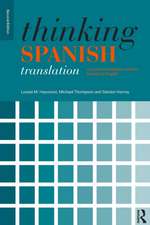Telling the Story of Translation: Writers who Translate: Bloomsbury Advances in Translation
Autor Professor Judith Woodsworthen Limba Engleză Paperback – 20 feb 2019
| Toate formatele și edițiile | Preț | Express |
|---|---|---|
| Paperback (1) | 230.79 lei 6-8 săpt. | |
| Bloomsbury Publishing – 20 feb 2019 | 230.79 lei 6-8 săpt. | |
| Hardback (1) | 773.88 lei 6-8 săpt. | |
| Bloomsbury Publishing – 9 aug 2017 | 773.88 lei 6-8 săpt. |
Din seria Bloomsbury Advances in Translation
- 23%
 Preț: 192.55 lei
Preț: 192.55 lei - 22%
 Preț: 257.03 lei
Preț: 257.03 lei - 21%
 Preț: 218.74 lei
Preț: 218.74 lei - 22%
 Preț: 225.24 lei
Preț: 225.24 lei - 22%
 Preț: 256.20 lei
Preț: 256.20 lei - 23%
 Preț: 198.30 lei
Preț: 198.30 lei - 14%
 Preț: 197.77 lei
Preț: 197.77 lei - 23%
 Preț: 192.48 lei
Preț: 192.48 lei - 22%
 Preț: 238.22 lei
Preț: 238.22 lei - 22%
 Preț: 259.34 lei
Preț: 259.34 lei - 23%
 Preț: 198.30 lei
Preț: 198.30 lei -
 Preț: 217.62 lei
Preț: 217.62 lei - 13%
 Preț: 257.03 lei
Preț: 257.03 lei - 13%
 Preț: 263.62 lei
Preț: 263.62 lei - 30%
 Preț: 569.06 lei
Preț: 569.06 lei - 13%
 Preț: 238.94 lei
Preț: 238.94 lei - 13%
 Preț: 181.77 lei
Preț: 181.77 lei - 30%
 Preț: 598.45 lei
Preț: 598.45 lei - 22%
 Preț: 239.02 lei
Preț: 239.02 lei - 23%
 Preț: 197.86 lei
Preț: 197.86 lei - 22%
 Preț: 256.59 lei
Preț: 256.59 lei - 11%
 Preț: 344.52 lei
Preț: 344.52 lei - 23%
 Preț: 191.04 lei
Preț: 191.04 lei - 24%
 Preț: 189.70 lei
Preț: 189.70 lei - 22%
 Preț: 258.42 lei
Preț: 258.42 lei - 13%
 Preț: 256.59 lei
Preț: 256.59 lei - 13%
 Preț: 257.12 lei
Preț: 257.12 lei
Preț: 230.79 lei
Preț vechi: 297.09 lei
-22% Nou
Puncte Express: 346
Preț estimativ în valută:
44.16€ • 46.23$ • 36.54£
44.16€ • 46.23$ • 36.54£
Carte tipărită la comandă
Livrare economică 05-19 aprilie
Preluare comenzi: 021 569.72.76
Specificații
ISBN-13: 9781350101036
ISBN-10: 1350101036
Pagini: 248
Dimensiuni: 156 x 234 x 16 mm
Greutate: 0.35 kg
Editura: Bloomsbury Publishing
Colecția Bloomsbury Academic
Seria Bloomsbury Advances in Translation
Locul publicării:London, United Kingdom
ISBN-10: 1350101036
Pagini: 248
Dimensiuni: 156 x 234 x 16 mm
Greutate: 0.35 kg
Editura: Bloomsbury Publishing
Colecția Bloomsbury Academic
Seria Bloomsbury Advances in Translation
Locul publicării:London, United Kingdom
Caracteristici
Pays particular attention to the insertion of the writers studied within specific linguistic, aesthetic and cultural communities and to their diverse motives for translating
Notă biografică
Judith Woodsworth is Professor of Translation Studies in the Department of French Studies at Concordia University, Canada.
Cuprins
1. Introduction: 'One More Possession of Beauty'2. Lost Masterpieces: Bernard Shaw and Translation3. Gertrude Stein and the Making of Translations4. Paul Auster: the Writer and his Double5. Epilogue: What is Translation For?ReferencesIndex
Recenzii
[The book] sheds new light onto a less-researched part of the literary career of three "literary decathletes" as she [Woodsworth] calls Shaw, Stein and Auster . Therefore, it is useful not only to students and researchers in the field of Translation Studies, but also to those interested in literary and cultural studies.
Something of a prophet in Canada, Woodsworth (French studies, Concordia Univ., Montreal) offers here a tripartite explication of translation strategies principally by three prominent authors: George Bernard Shaw, Gertrude Stein, and Paul Auster. En passant, Woodsworth exposes the complex lives and extensive bibliographies of the three writers to yield insights into their acts of translation and interpretation. Explored are links between translating and (re)writing by these eminent authors who translate and how they conceptualized or even fictionalized the task of translation. The evolution of the translator's voice and visibility is also scrutinized. Woodsworth's case studies illuminate a teleology of translation, insofar as the process may pay tribute, repay a debt, or cement a friendship. Bleak tales of loss, counterfeit, or hard labor may yet also complement with fresh perceptions, allowing translation, finally, to be taken not as a subservient art but as a literary act in its own right. Woodsworth's epilogue steps along further with discussion of three genre-bending and multidimensional storytellers: Jonathan Safran Foer, Rachel Cantor, and Idra Novey. Including extensive notes, this volume will be extremely useful for scholars in linguistics and translation studies. Summing Up: Highly recommended. Upper-division undergraduates through faculty.
Something of a prophet in Canada, Woodsworth (French studies, Concordia Univ., Montreal) offers here a tripartite explication of translation strategies principally by three prominent authors: George Bernard Shaw, Gertrude Stein, and Paul Auster. En passant, Woodsworth exposes the complex lives and extensive bibliographies of the three writers to yield insights into their acts of translation and interpretation. Explored are links between translating and (re)writing by these eminent authors who translate and how they conceptualized or even fictionalized the task of translation. The evolution of the translator's voice and visibility is also scrutinized. Woodsworth's case studies illuminate a teleology of translation, insofar as the process may pay tribute, repay a debt, or cement a friendship. Bleak tales of loss, counterfeit, or hard labor may yet also complement with fresh perceptions, allowing translation, finally, to be taken not as a subservient art but as a literary act in its own right. Woodsworth's epilogue steps along further with discussion of three genre-bending and multidimensional storytellers: Jonathan Safran Foer, Rachel Cantor, and Idra Novey. Including extensive notes, this volume will be extremely useful for scholars in linguistics and translation studies. Summing Up: Highly recommended. Upper-division undergraduates through faculty.








